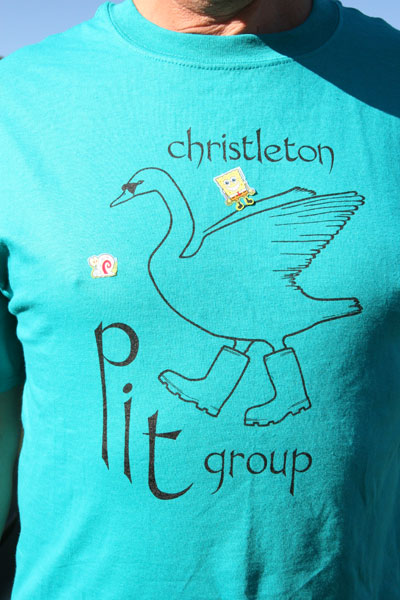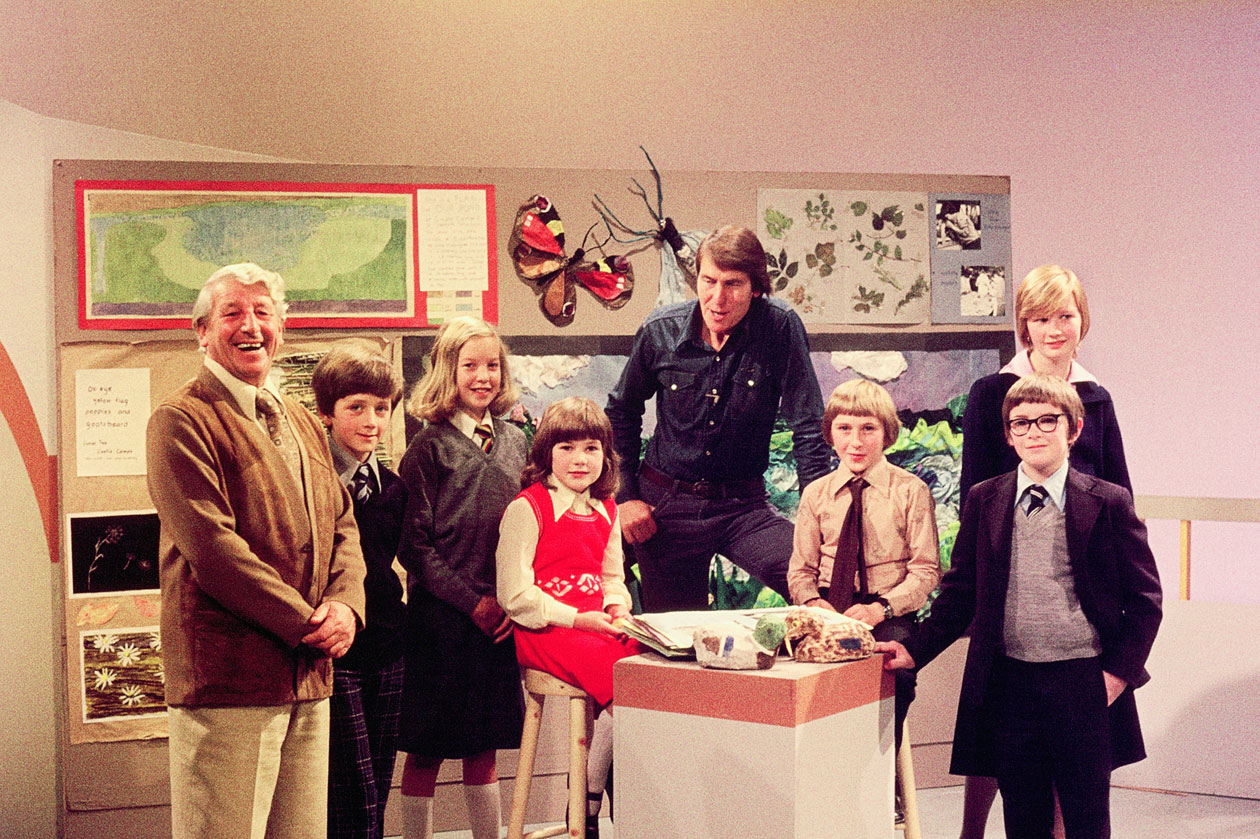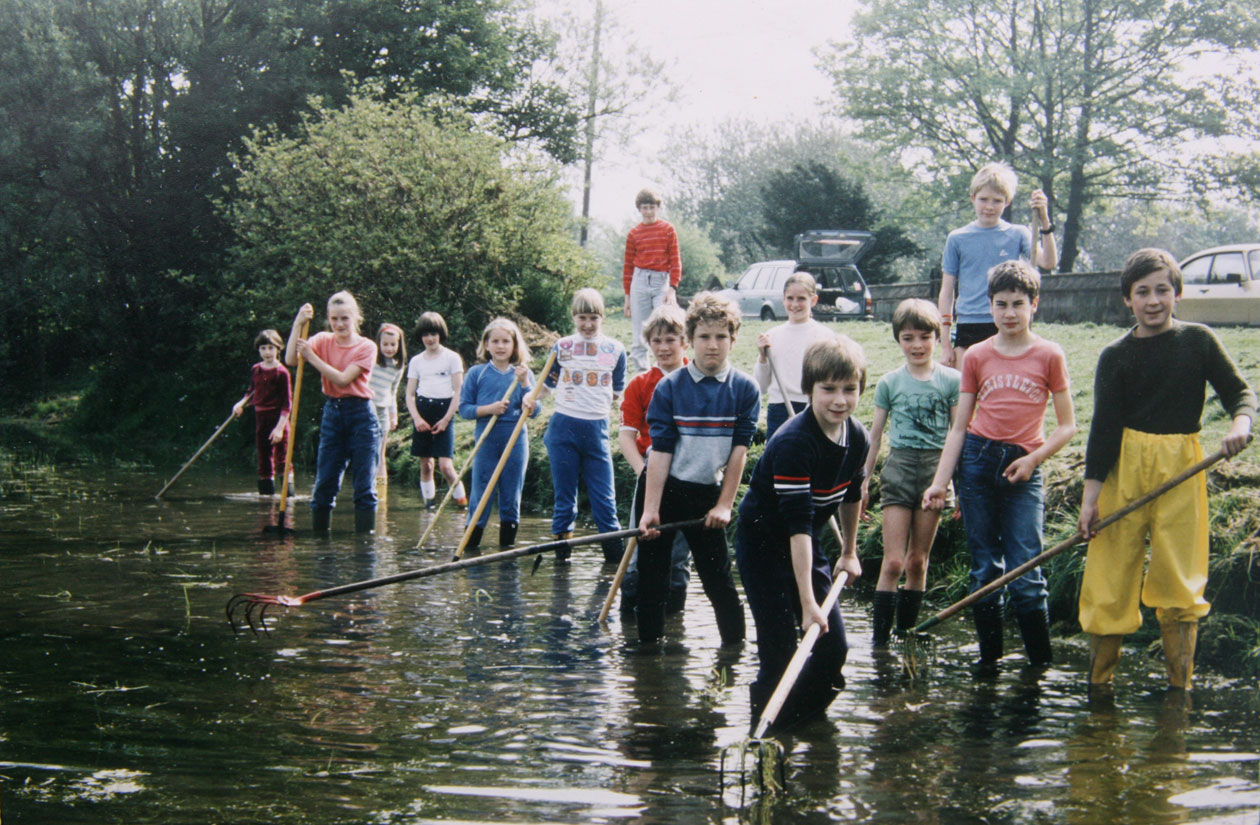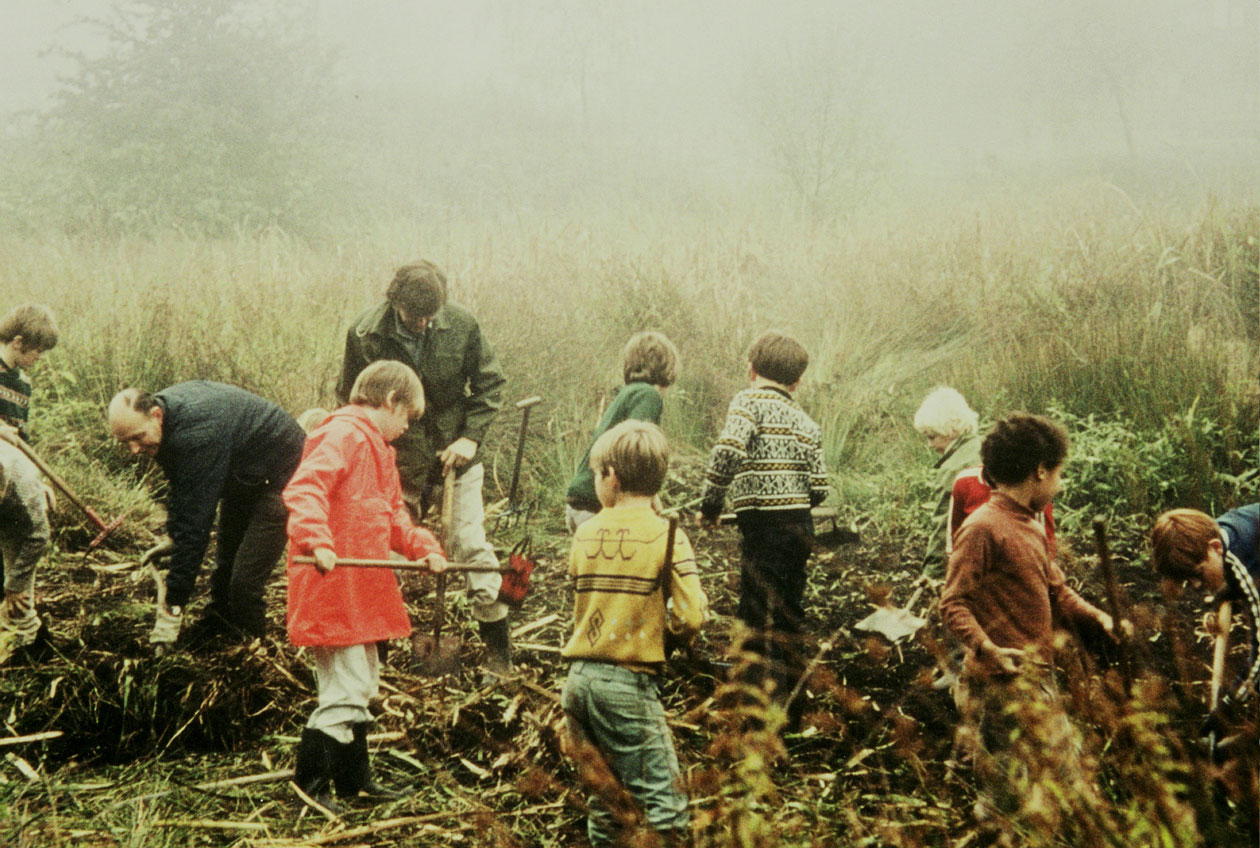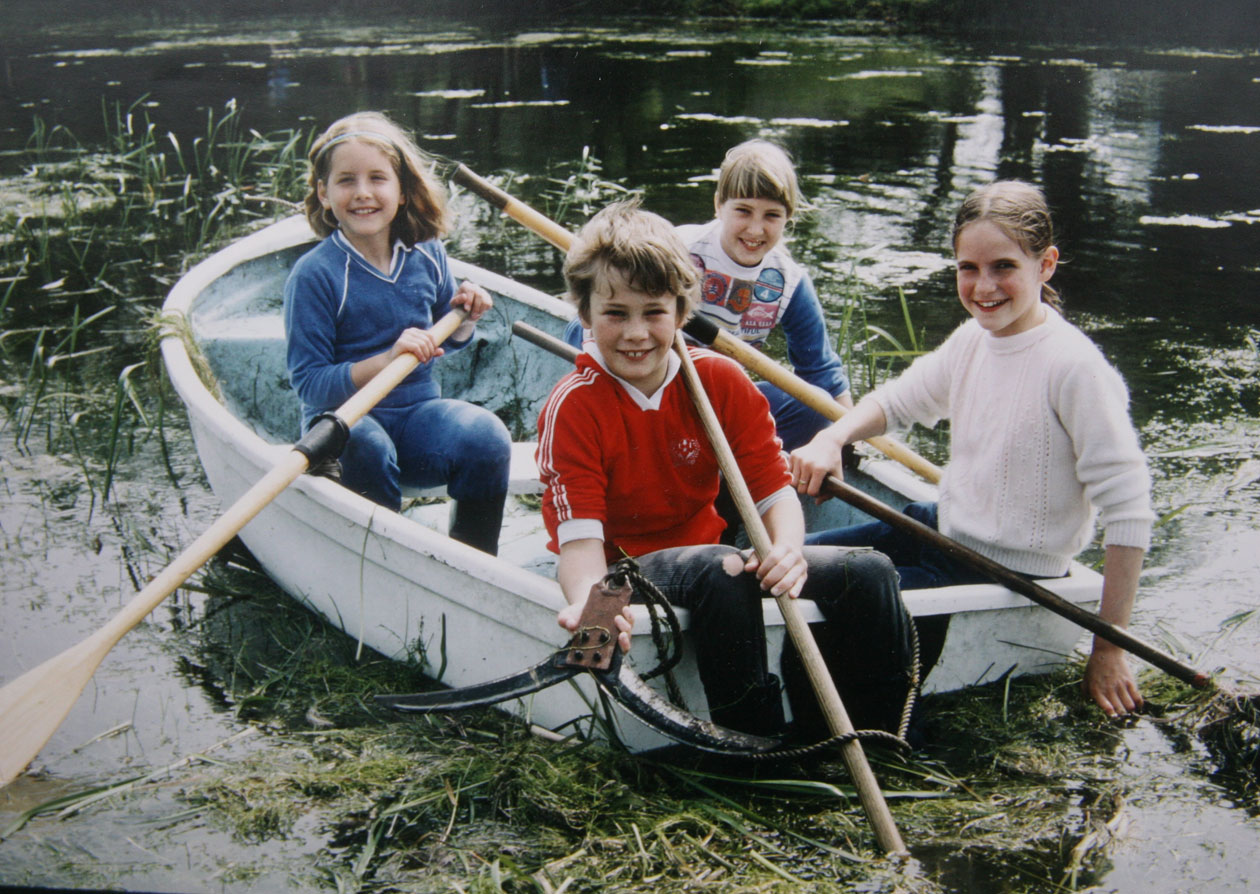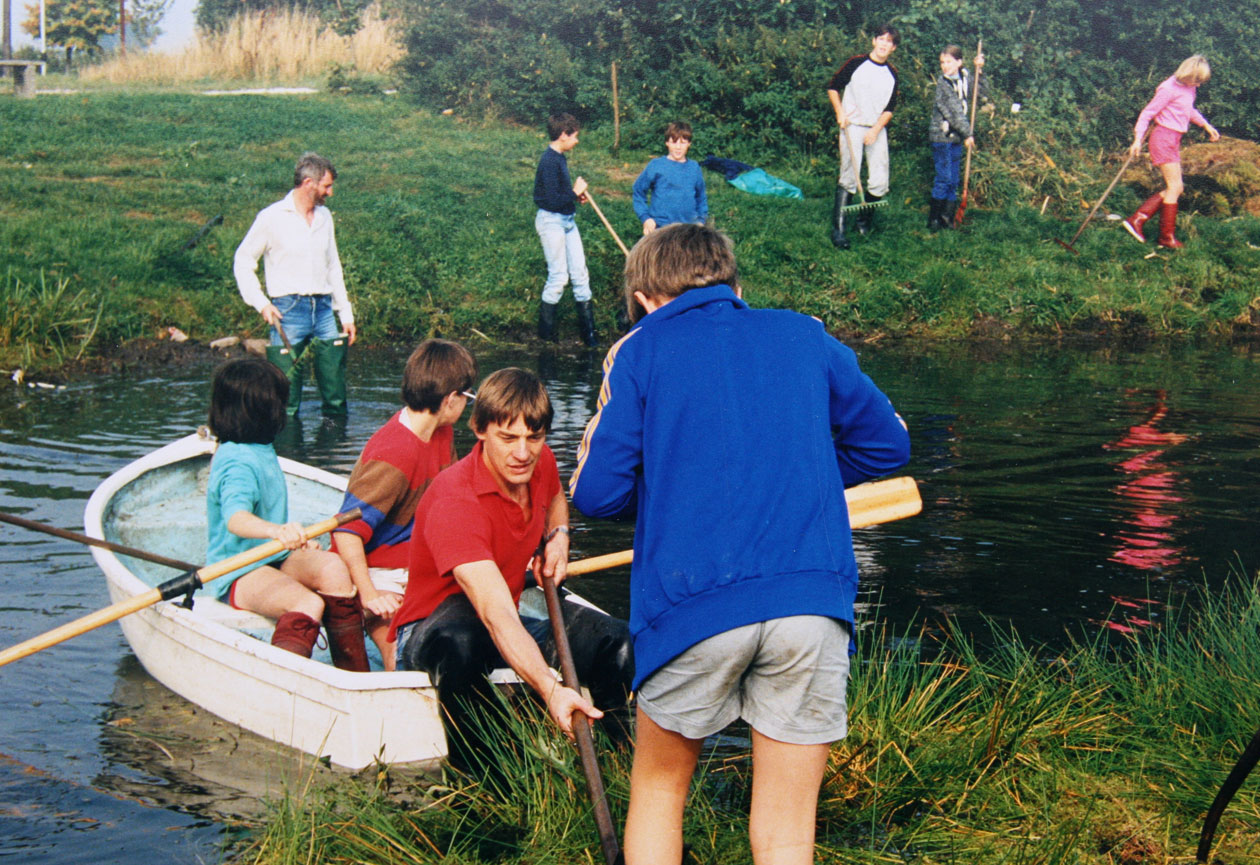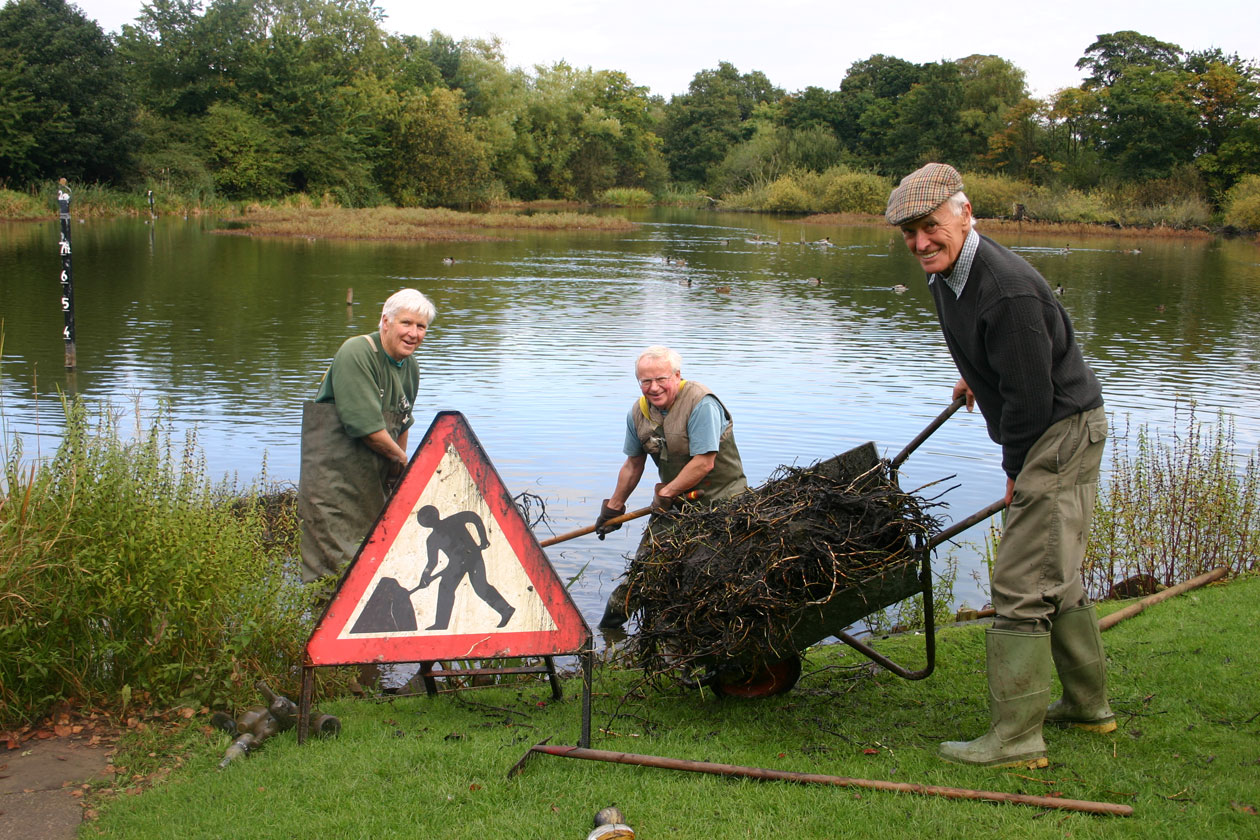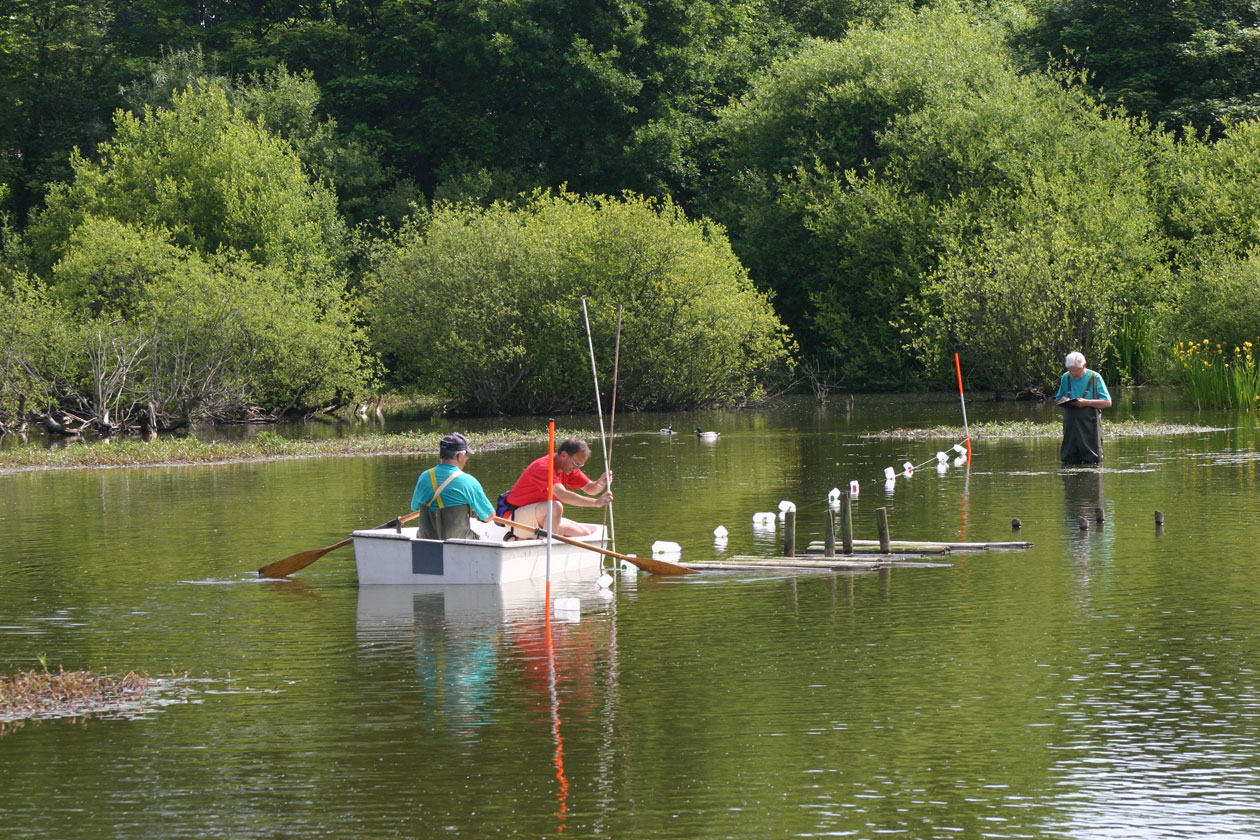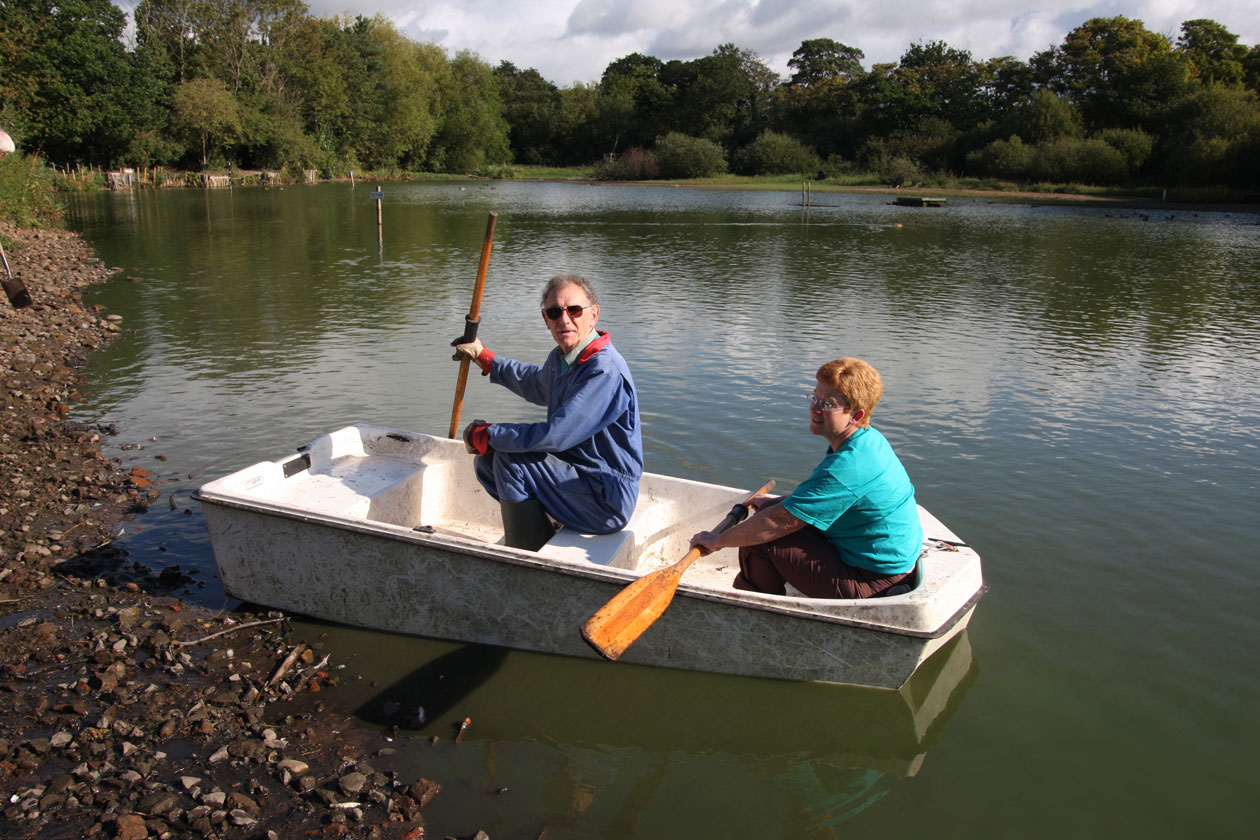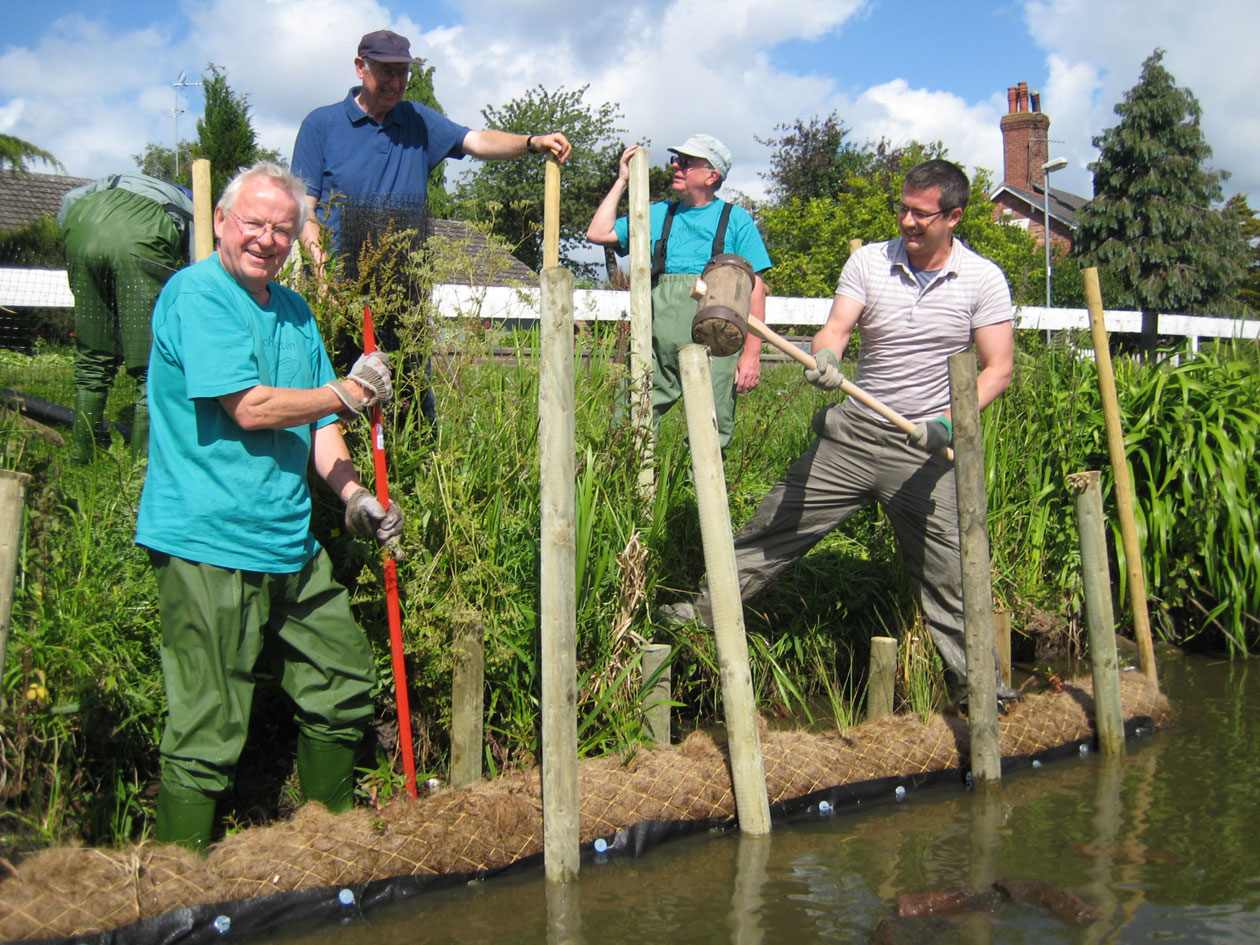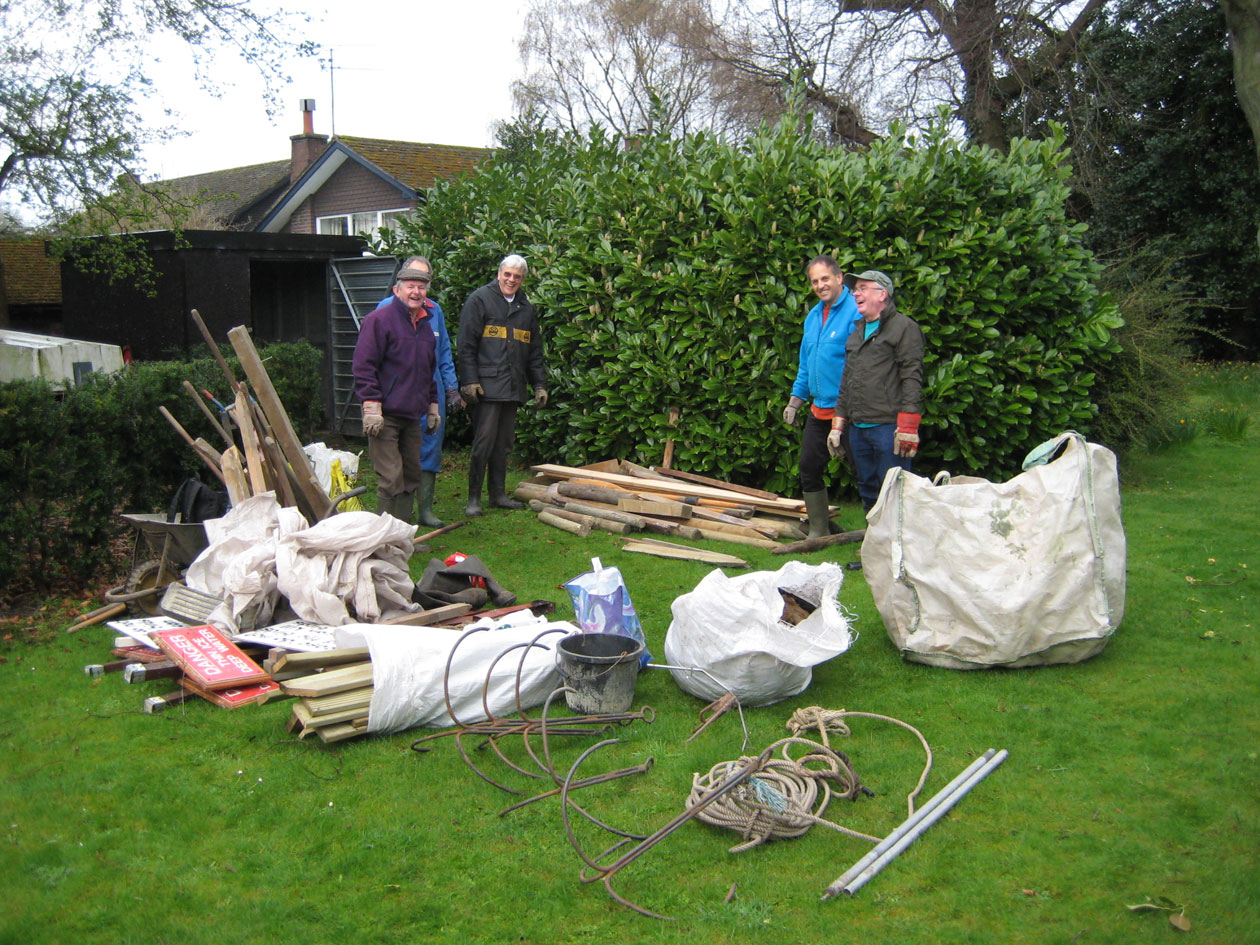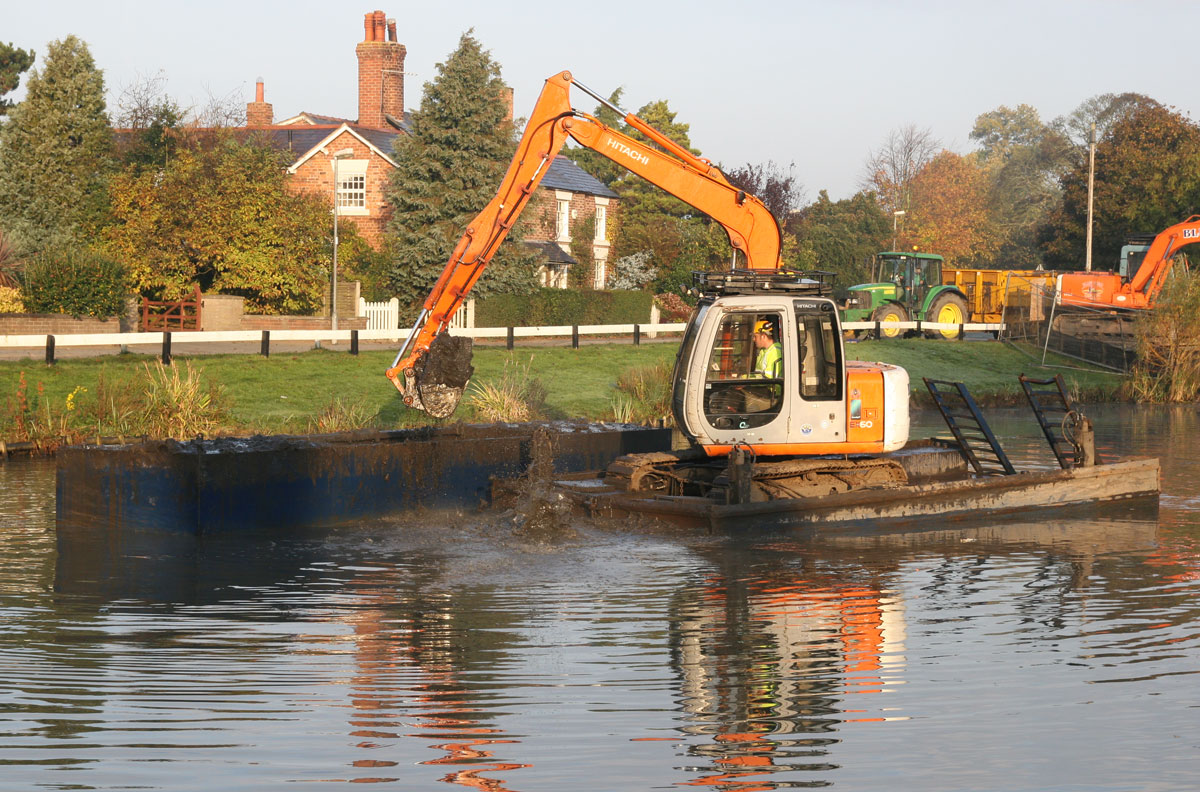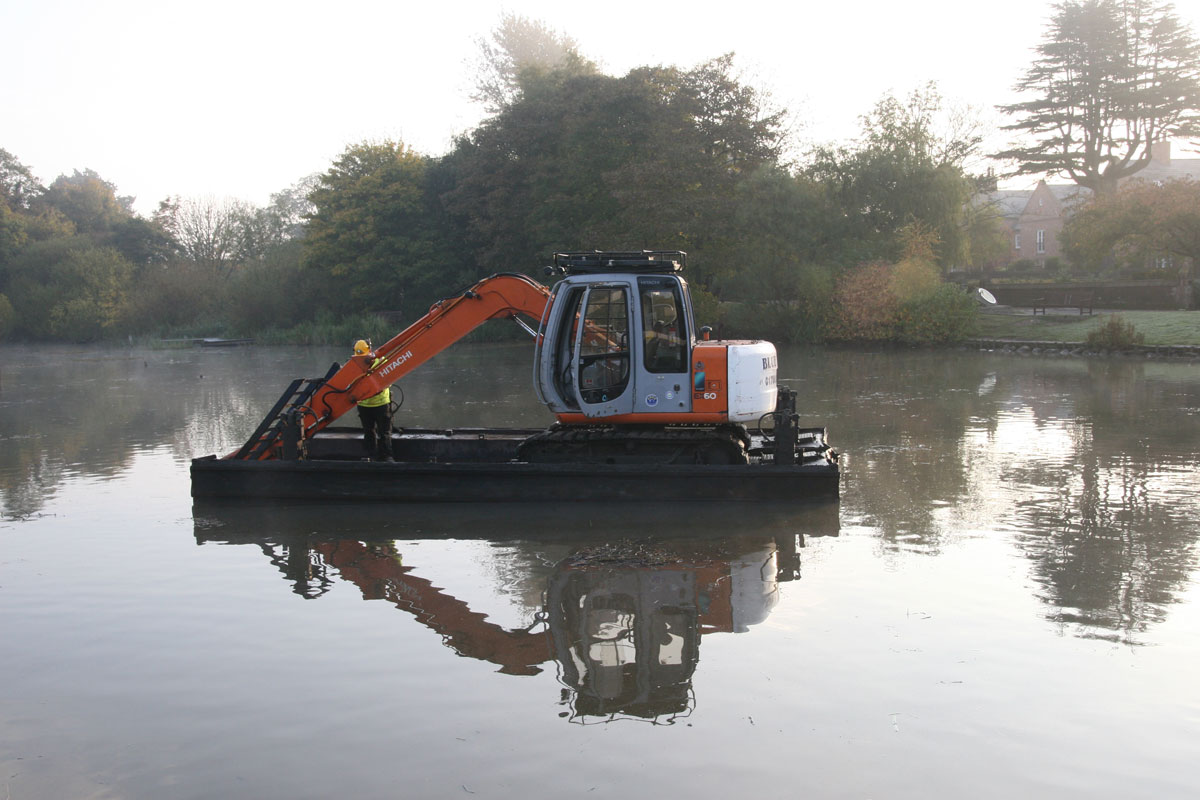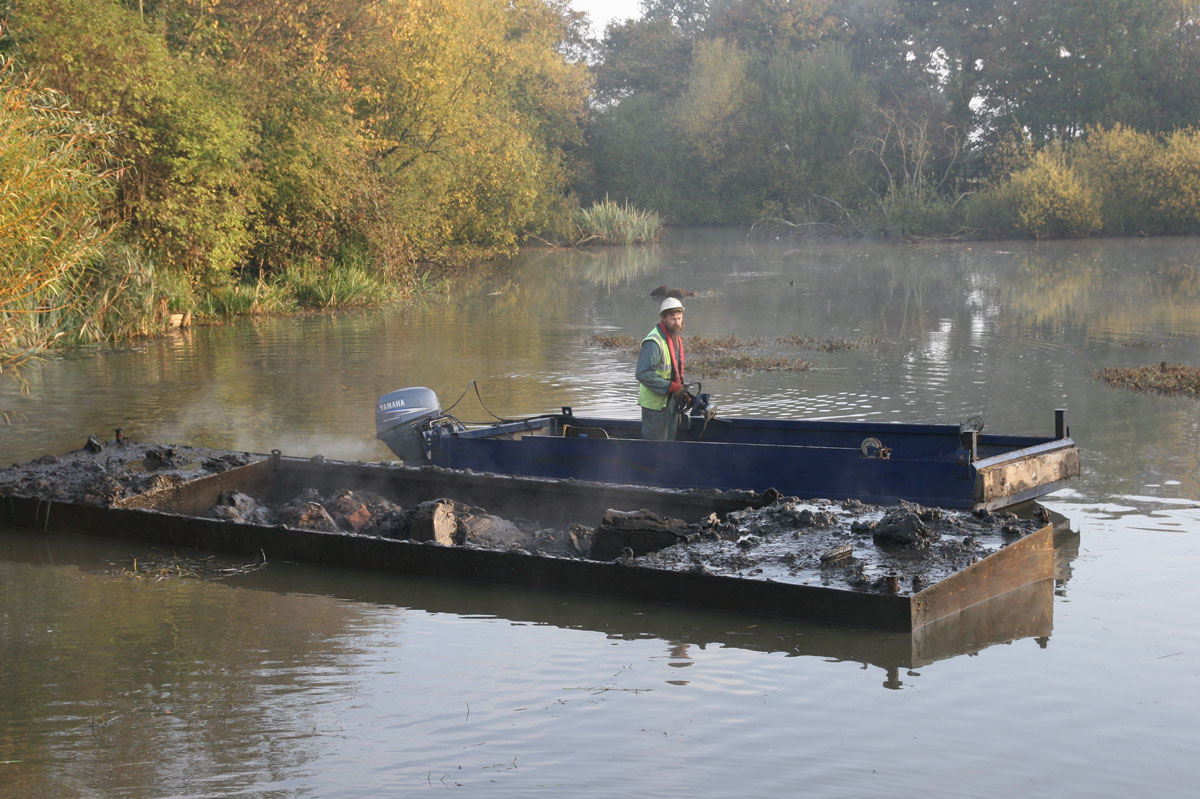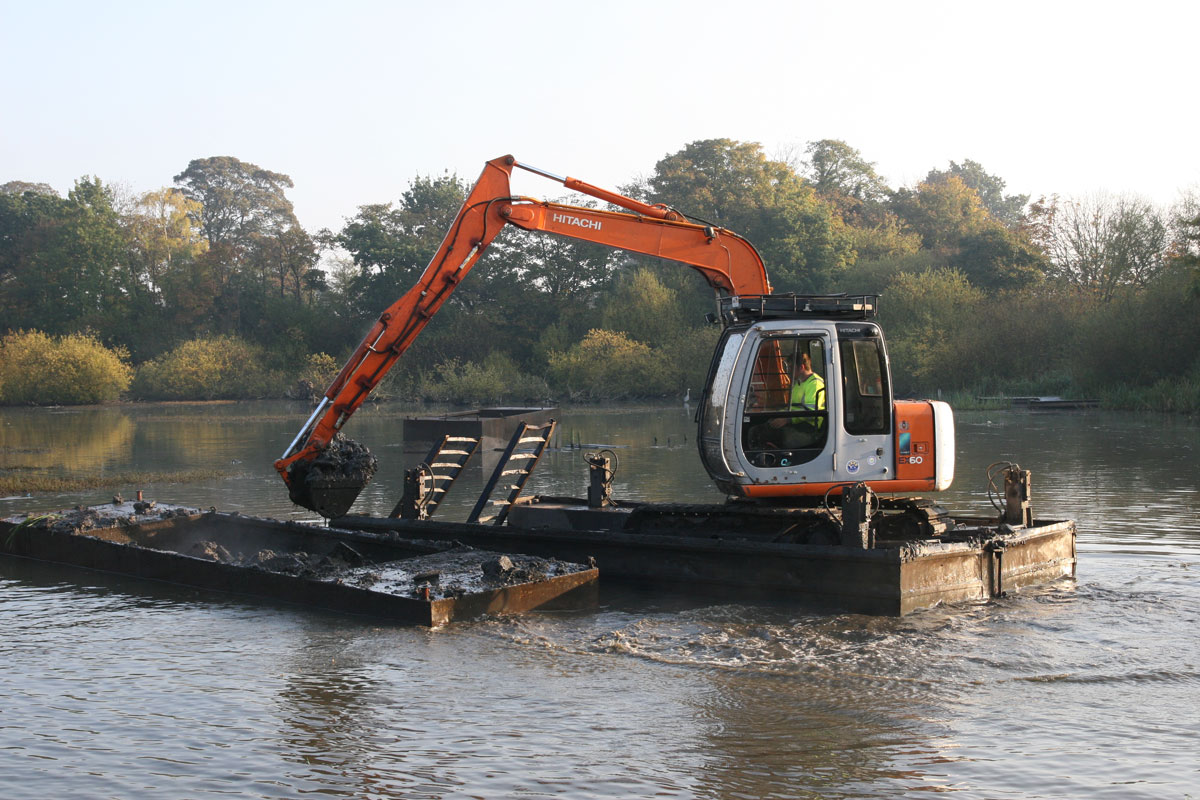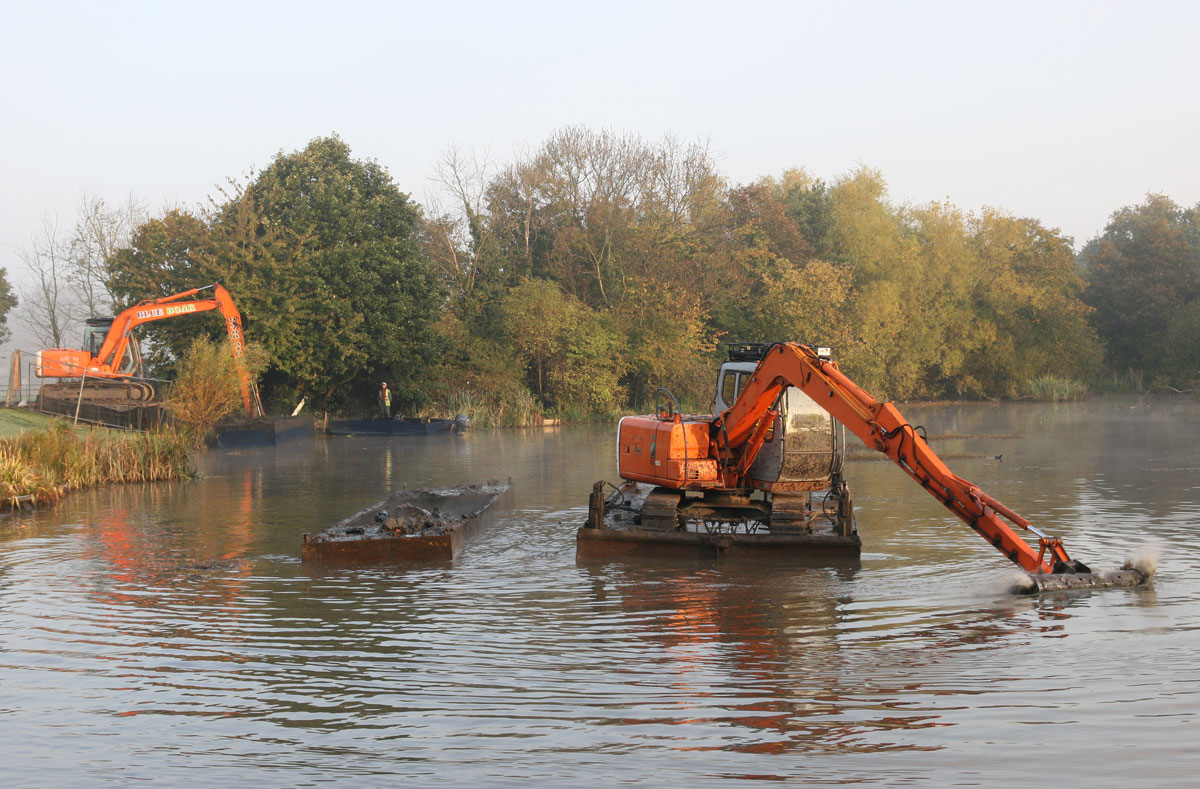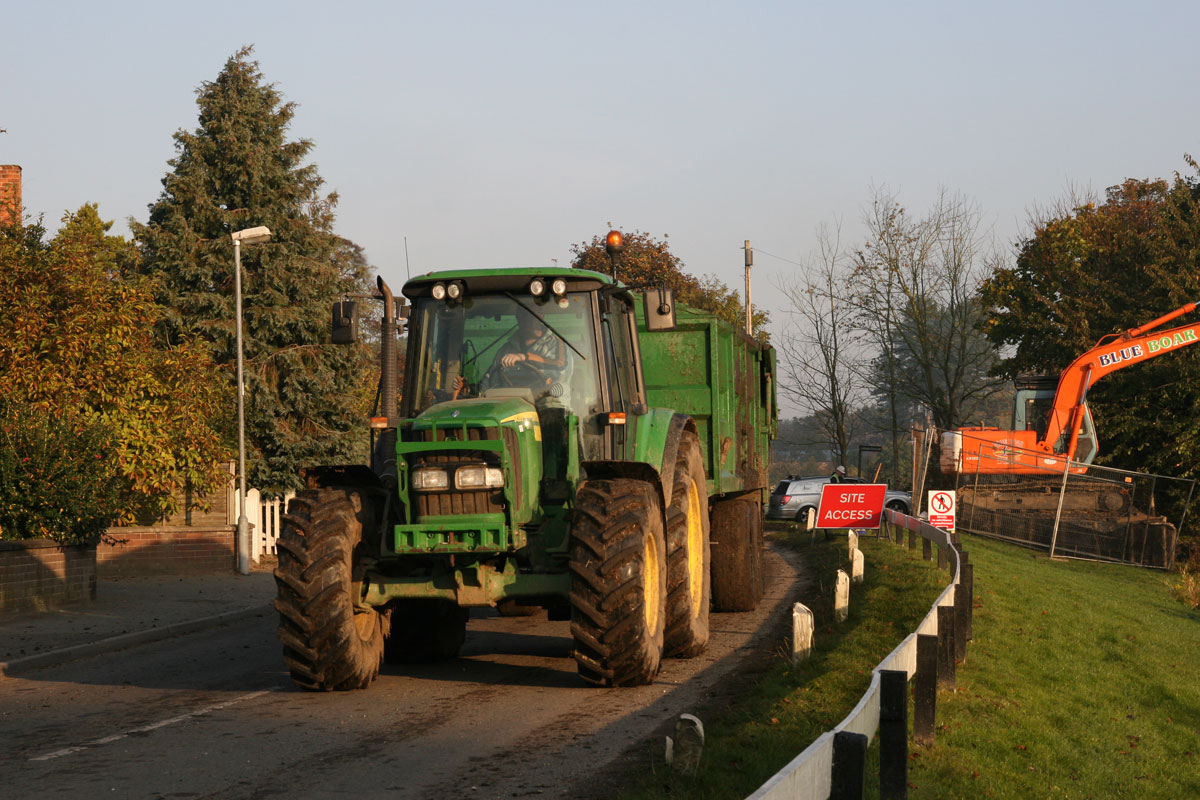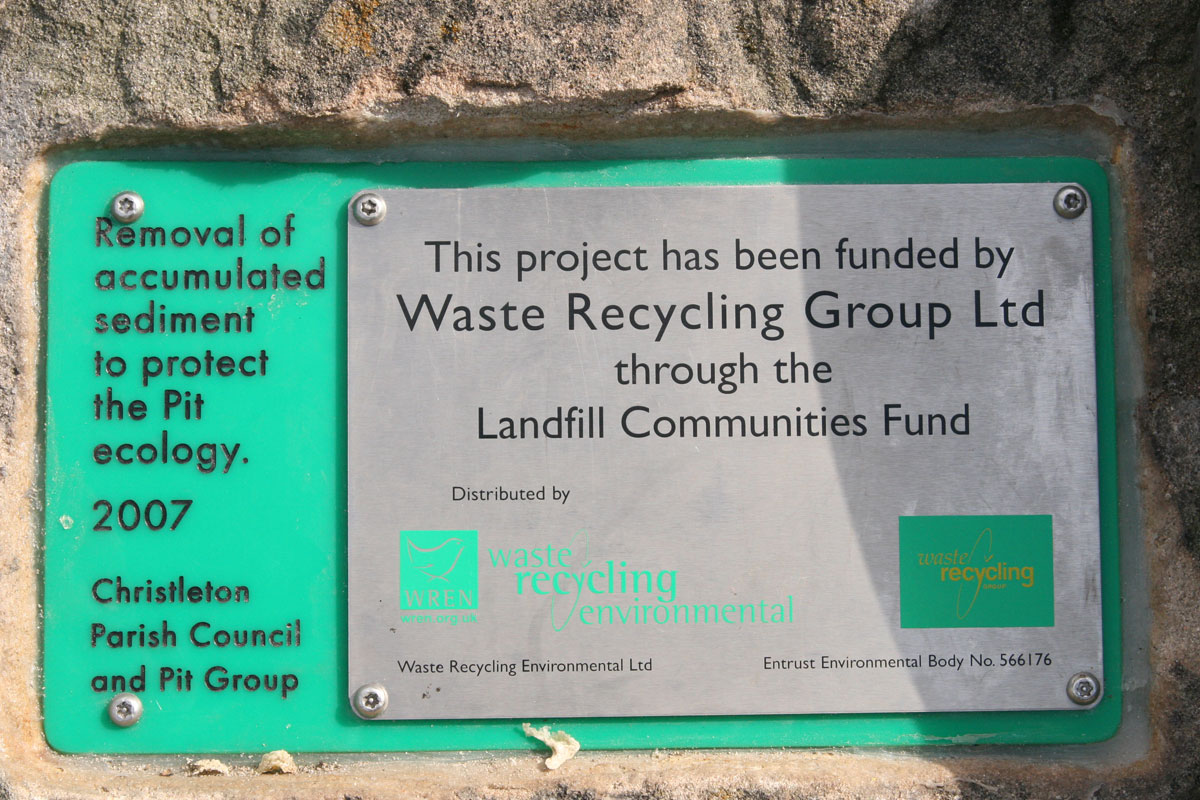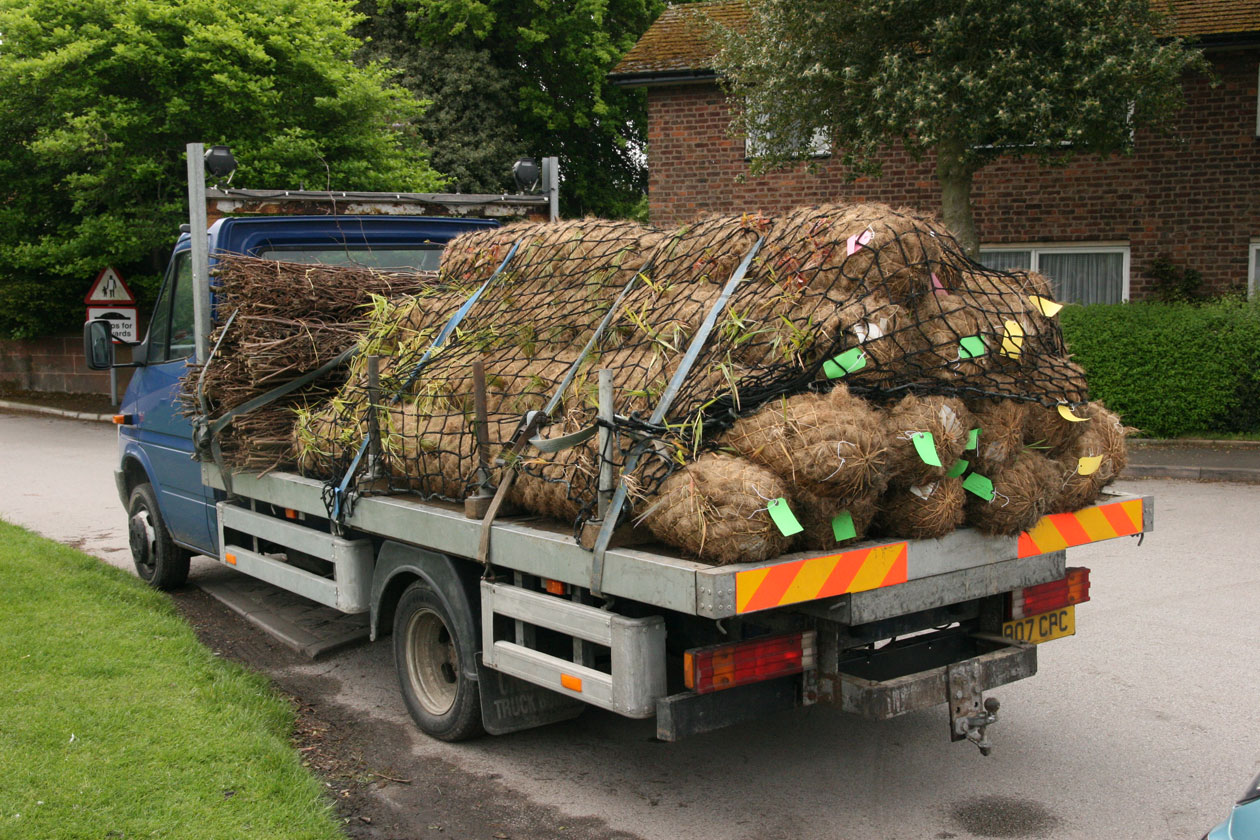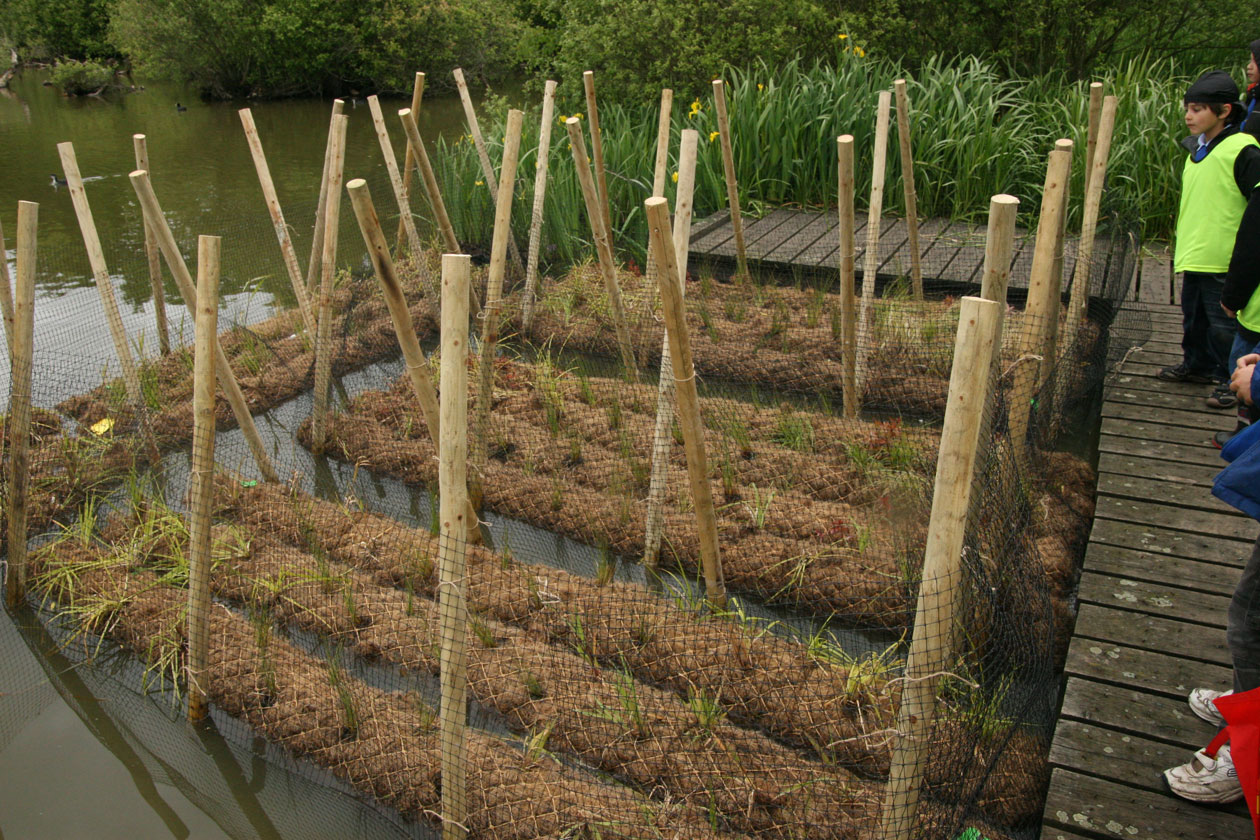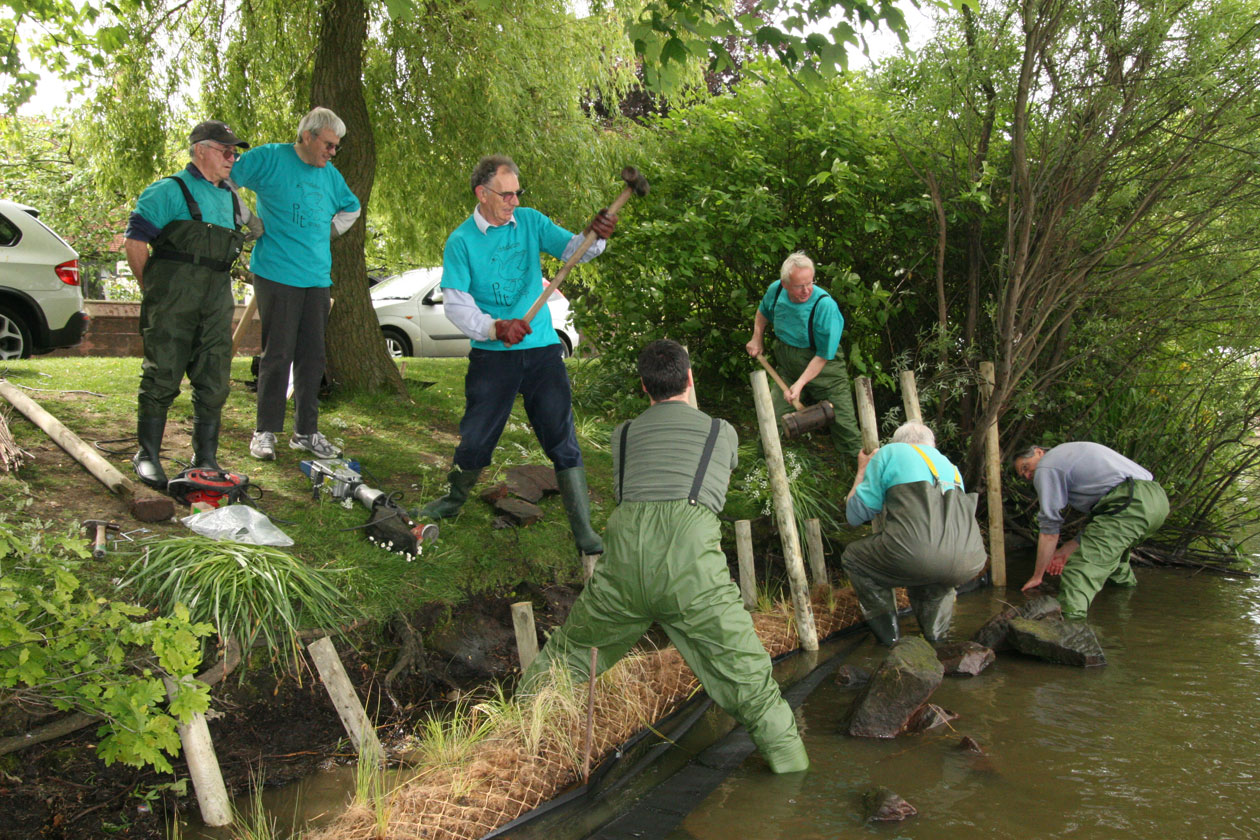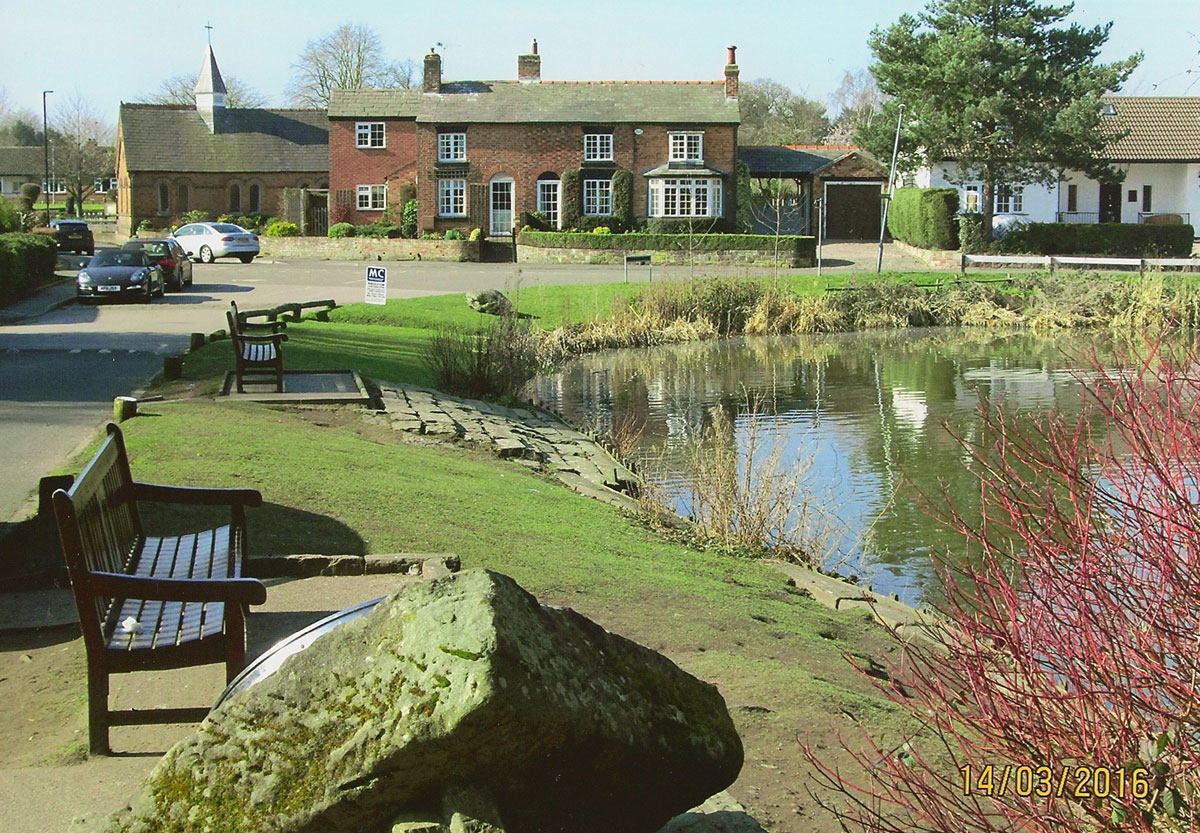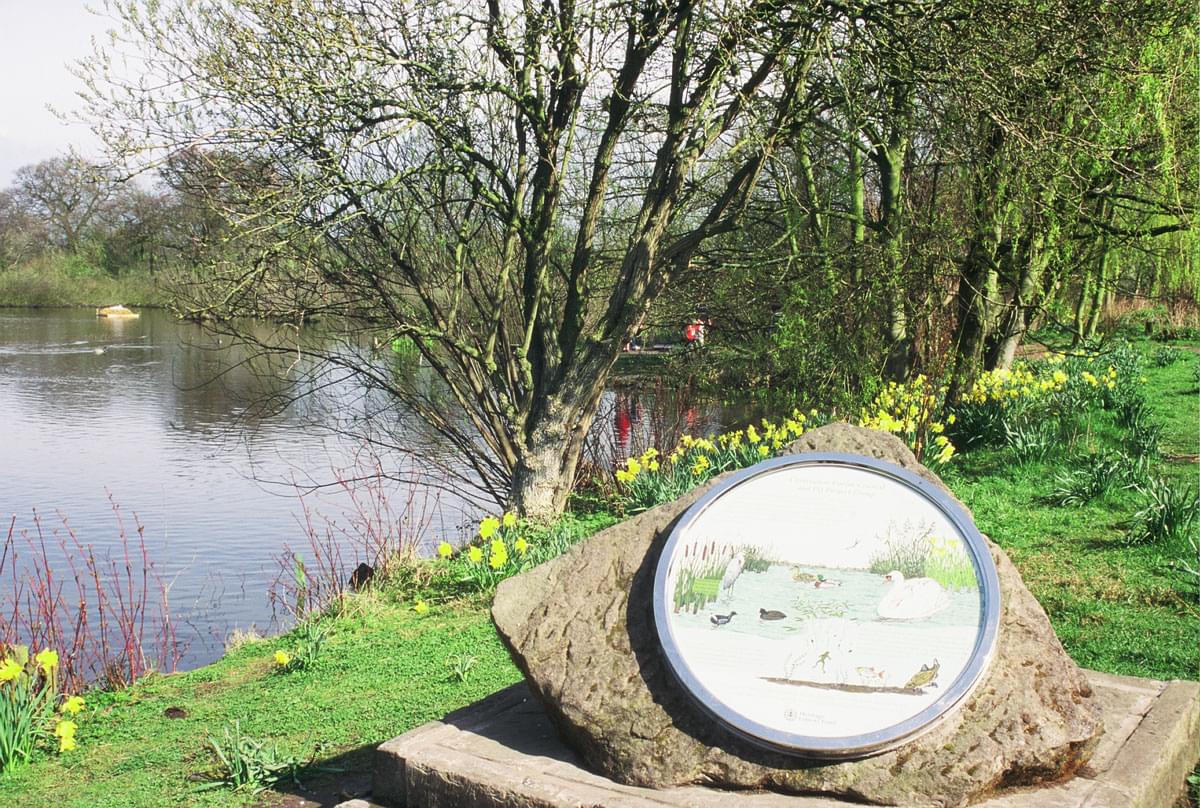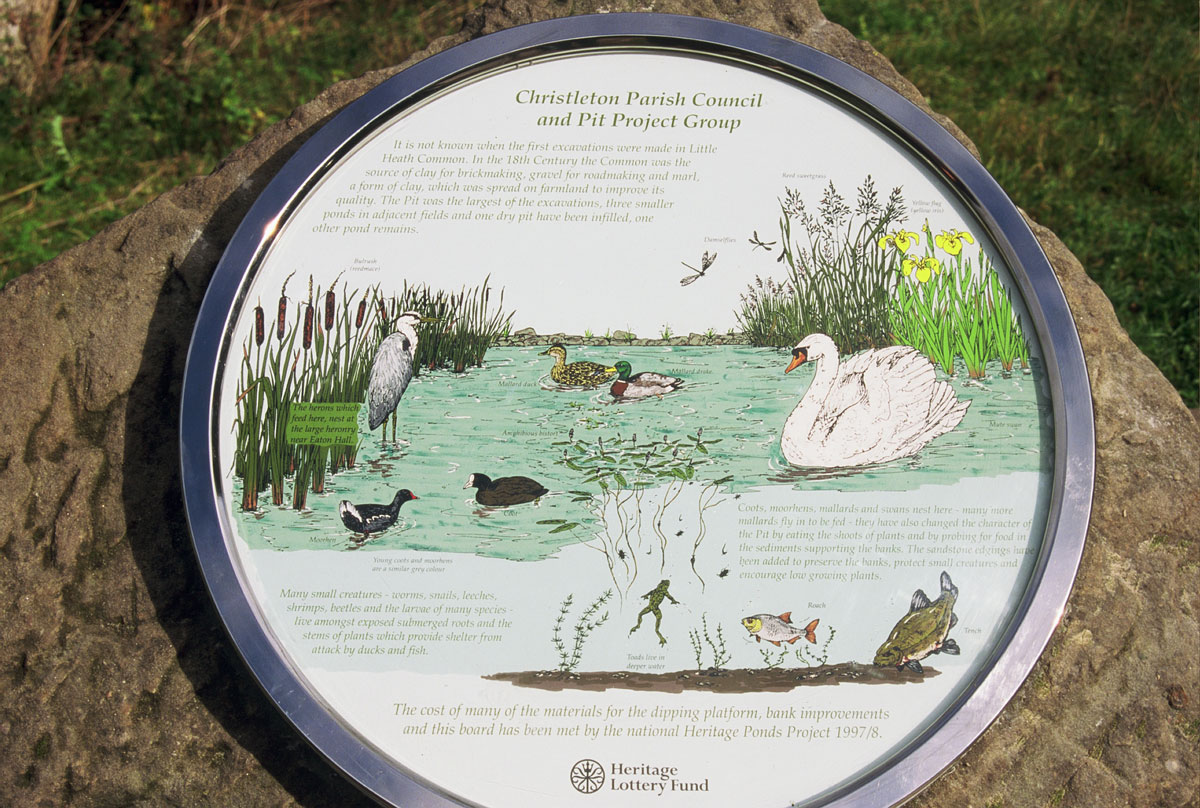
Introduction
Christleton Pit Group consists of a group of volunteers from the Parish who have maintained the area at Little Heath including the Pit for over 30 years. The project actually started in 1974 when an entry, written and created by children from the Primary School, won second prize in the Dailey Telegraph “Save the Village Pond Campaign” The children received their prize at the BBC studios in Bristol, when they appeared on ”Animal Magic” the Children’s TV programme hosted by Johnny Morris and Tony Soper. The acclaim gained by the children, made villagers aware of the fragile nature of “The Pit”, and the severe droughts of 1975/6 which resulted in the Pit being completely dry, brought the story really into focus. The rescue of the Pit which followed in subsequent years, saw children and their parents led by Headteacher David Cummings*, attempt to conserve the area as well as they could, and even search for any source of water that could help fill “The Pit”.
*David became involved in conservation work in the village in 1972, when Barbara Redwood and Anthea Brian contacted him as the new Headteacher of the Primary School, inviting him to allow pupils from the school to become involved in their environmental survey of Christleton Parish. The Redwood/ Brian survey is still a model for others to follow, and is probably one of the most detailed environmental studies of any village yet carried out. The children helped by collecting information about plants, trees, birds, butterflies and animals, and then surveying, mapping and later making a scale model of the pit. In 1974 their work was displayed in Gamul House in Chester, and the completed Parish Survey was exhibited at the Primary School, and visited by Gerald the late Duke of Westminster who showed great interest in the work.
-

Christleton Pit
-

Christleton Pit
By the mid summer of 1976 “The Pit” had resembled the surface of the Arizona Desert, with large cracks all over the dried out surface and there was virtually no water or even mud to be seen. The notice "Private Water" at the edge to deter fishermen became a huge local joke, but concern about the future of the area was real. With the support of Bowater Paper Corporation, the Parish Council arranged for a small tracked vehicle to try to excavate the silt and mud from the pit area. Unfortunately although the crust appeared to be hard and dry, the surface collapsed in parts as the vehicle tracked over it, and after a few hours of clearance the vehicle was firmly stuck in an area of thick boulder clay. The loan of a machine for a morning became three days, as even a second tracked vehicle became stuck trying to rescue the first, and both had to be dug out largely by hand. The initial work of the first vehicle had however cleared a channel around the outside of the pit and this proved to be very valuable in creating space for a deep trough of water for future years. Villagers were also encouraged to come to take barrow loads of good "garden silt" away, and hundreds of barrow loads of soil were removed that summer.
Thankfully the autumn and winter of 1976 proved to be very wet indeed and the deep channel around the outer edge rapidly filled with water, and even the central surface area was submerged. This deep channel has proved to be the saving of the pit and even today after 40 years still is over a metre and a half deep, always holding water whatever the weather conditions have been. The change to more intensive arable farming, with the subsequent filling in of several feeder ponds has since resulted in additional nutrients leeching into the pit and loss of some water supply. This might have also been the consequence of nutrients being released into the pond when the horsetails were killed with weed killer. The shallowness of the central area also caused springtime algal blooms and at times the ponds surface area resembled a dark green pea soup. However this was in fact a good indicator sign that oxygen was getting to the water, and there was excellent plant growth. However that plant growth was not really what we wanted, and it soon resulted in the central area becoming like a thick carpet.
-
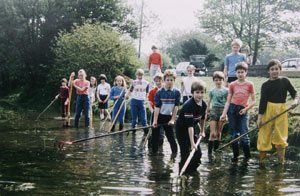
Christleton Pit
-
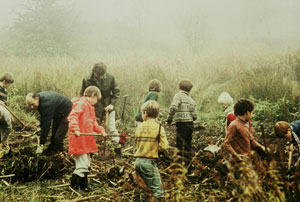
Christleton Pit
-

Christleton Pit
-

Christleton Pit
In the late 1970's the Primary School children and several parents began to meet each week to carry out work at the Pit, and this project grew to involve hundreds of children who worked on Friday evenings and Saturday mornings through Spring, early Summer and Autumn. The children were enthusiastic and they had the wonderful excuse of getting covered in mud each time with no one ever grumbling at them, because they were working to conserve their local environment. What today's health & safety rules would say of the way the children worked and the tools they worked with I'd hate to think, but these were special days, and we were very proud of the efforts and the contribution to the cause that the children made over many years. Many of those young people have gone on to study aspects of Natural History, and after University Courses have obtained full time employment in environment agencies and river authorities. The children regularly made the local press with their achievements, and a book for children about British Wildlife and the Environment published by Hamlyn included a chapter about their work at the Pit. Further articles appeared in the annual report of the North West Civic Trust, and in magazines of the Conservation now Wildlife Trusts.
Later articles appeared in the Methodist Church /Home Magazine, and the children's work was nominated for awards by the RSPB, the Wildfowl & Wetland Trust, and Cheshire County Council's first Environmental Award Scheme for Schools. However despite their enthusiastic efforts, the central area began reverting to being a swamp, and further more drastic action was needed.
The Christleton Pit Group

In 1988 the Pit Group was formed under the Chairmanship of John Salter, with Eric Kenyon, Ian Gorst, Derek Bell, Tony Gardner, Phil Haywood, Gerry Crees, Charles Smeatham and David Cummings among others as committee members. The first working parties met on the 1st and 8th October in that year, with the intention of making sure that the pit was restored for the future enjoyment of the village community. There was again immediate support from the Parish Council, both financially and of a practical nature.

Plans for the long term future of the Pit were drawn up, based on the limited knowledge that we had acquired over the years. We sought advice from organisations such as the Conservation Trusts and the then Nature Conservancy Council, but no one had tackled the problems we faced with such a large area of water, over 2 acres in fact. With the days of the old traction engines that cleared such ponds with drag lines long gone, no one it seemed had the technology we needed for such a difficult task. One of the first decisions was to decide what the problem really was. Did the geology of the area affect the water level? Could we get an additional source of water from nearby? Geoff Clifton very kindly offered the services of his company Gifford & Partners in providing a borehole survey, which indicated to us the various depths of clay, silt and sand in the pit area, and from this we devised our action plan.
Our main aims were;
a. to clear areas of vegetation to enable a good
surface area of water to be seen by the
public, and used by wildlife.
b. retain the area at the back of the pit as a
secluded wildlife reserve.
c. remove some of the accumulated silt and
mud.
d. create a new & safe pond edge to prevent
erosion and act as a natural barrier.
e. create additional areas of seating for the
public.
Since then many other challenges have emerged, but we have always kept to the basic principle that the pit has to be a place of importance for wildlife, and a valued amenity and place of enjoyment, for as many sections of the community as possible. Over the years fishing and pond dipping platforms have been built, seats provided, a sandstone buffer provide to prevent erosion of the banks, a silt trap to prevent surface oil from the road reaching the water, and a swans' nest site has created.
All these objectives have been met, often using recycled materials from old telegraph poles, discarded curb stones to slabs of unwanted paving stone. Team members have had to learn new skills to use these materials, but we have always been fortunate enough to have members with enthusiasm and commitment to the work to turn up whenever work is required.
-
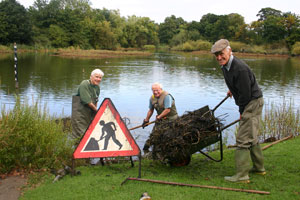
Christleton Pit Group
-
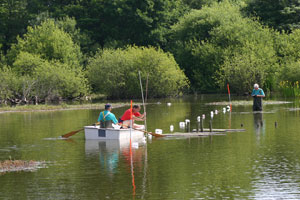
Christleton Pit Group
-

Christleton Pit Group
-

Christleton Pit Group
-
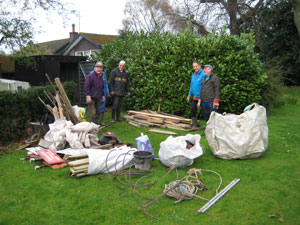
Christleton Pit Group
There has also been the wonderful support of other members of the community, not only in providing financial support in our fund raising, but vehicles, tools and equipment when needed. The Arden Family were foremost among them with the regular loan of equipment, and from our link with them through the Parish Council and the late Jim Partington. We also benefited from help from the Dandy Family of Littleton, the Beech Family from Brown Heath Farm and we would have been lost without the special help of Shell UK with their most generous support of workshop space for the development of equipment, especially the "Drag Queen", and loan of expensive cranes and lifting tackle when needed. Shell also arranged the loan of an enormous crane from Ainscough’s which lifted complete trees out of the Pit for us!.
Our main link to Shell UK was the late Ian Gorst who was the inspiration in providing solutions to our most difficult problems. We have also benefited enormously from having the artistic and creative skills of Eric Kenyon. Eric provides the drawings and plans that we work to, and has now become an expert in pond conservation, and is recognised as such by the Heritage Ponds Group.
The "drag queen" mentioned was not a medieval torture, but an ingenious device for dragging along the bottom of the pond removing unwanted rhizomes and reeds without damaging the ponds base. It looked rather like a supermarket trolley mounted on a sledge, which was attached to a long hawser and towed through the water, itself pulled by the long jib of a crane. This device guided by Ian and others in wet suits was instrumental in clearing the heavy matting of material that had accumulated very rapidly in the central area of the pit in the years between 1976 and 1986. The material was removed from the central area by boat and canoe, taken to the side of the pit where it was removed by other members, and deposited on areas of farmland or burned.
The contribution by Shell is recognised by the Shell Logo on the top of the water depth posts on either side of the pit. Each year working parties are organised to clear or maintain certain aspects of the pit, and all the improvements have created what is accepted as an excellent amenity for the village, creating a balance between the needs of the natural world and the community. Work will only take place when absolutely necessary, so as not to disturb the pond, plant and wildlife community.
2009 Dredging by Blue Boar
During the winter of 2006/7 we were made aware of the possibility of funding being made available towards the deepening of the Pit. Secretary Eric Kenyon as he had done all through the project, produced working plans for a possible scheme and the spring and summer of that year saw members surveying silt depth levels all around the pit from a boat to provide the evidence of what was needed. The Parish Council as always gave their backing to make the scheme viable. Later In 2007 the Project was awarded a considerable sum of money from a landfill tax source by WREN that when match funded locally enabled the Parish Council to engage the Blue Boar Company from Rugby to help remove large amounts of silt from the Pit. This was completed during the autumn and was done using a small tug’ boat powered pontoon holding a small hymac digger, which could be moved into any section of the pit that needed deepening. The silt & mud removed was then placed into an engineless butty boat which was pushed by the tug to the corner of the pit, where a further grab placed the wet material onto a waiting tractor & trailer and taken to be spread on nearby fields. Arden’s provided the tractor assistance continuing their involvement with the project since it began.
-

Dredging Christleton Pit
-

Dredging Christleton Pit
-

Dredging Christleton Pit
-
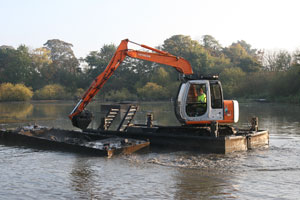
Dredging Christleton Pit
-

Dredging Christleton Pit
-
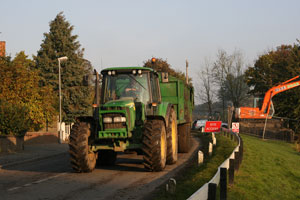
Dredging Christleton Pit
-
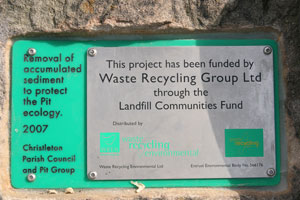
Dredging Christleton Pit
Improvement of the Pit edges with coir rolls
Arden’s also helped in 2009 with tractor power when another scheme was implemented to restore and improve the quality of the banks and pit edges. A tractor took the heavy 2m long coir rolls from a lorry parked near the Alms houses to a temporary dock alongside the children’s dipping platform until the pit group could carry out the scheme. Members of the group gave hundreds of man hours driving stakes into the ground to pin the coir rolls containing native English plant species in place, and the areas were then protected by netting to stop the ducks feeding on the new vegetation. The new edge based on our knowledge of the area over many years was seen to be a great success until a considerable drop in the level of rainfall during the summer months caused some of the plants to wither and die. In subsequent seasons these plants have recovered and the water level has remained extremely high and as I write in October 2016 the water level is currently too high for us to do planned restoration work to the banks and fishing platforms on the Littleton side of The Pit.
-
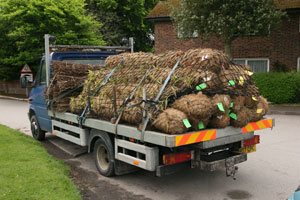
Christleton Pit
-
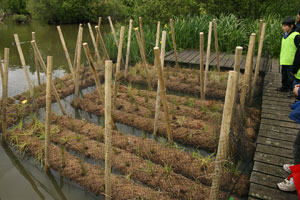
Christleton Pit
-

Christleton Pit
Overview
When the pond conservation work started we were almost working in the dark, and perhaps in hindsight have done some things that might have caused more harm than it should, the removal of large stands of bull rush, combined with the introduction (unknown to us at the time, of fluoridated tap water) killed off virtually the whole community of plants and thousands of pond creatures. This created a beautiful pond, but it was devoid of important elements, e.g. plants vital for the growth of insects and home to many aquatic creatures. Although we looked for advice from national organisations at the time decisions were taken, virtually none was available, but thanks to the Heritage Ponds Project and the work of Penny Williams, Jeremy Biggs and others from Oxford Brookes University, there is now a bank of knowledge available to pond rescuers in the future.
Our involvement with the National Heritage Pond Project was a direct result of our project being nominated by Dr Andrew Hull of John Moore’s University in Liverpool as a Heritage Pond for the North of England for the Millennium Pond Project. In 1999 the project achieved national status, and our pond was one of ten ponds chosen across the nation to illustrate the conservation value of ponds to local communities. The strength of the Christleton Pit Project was that it was the only one that was truly community based, receiving almost no outside assistance from bodies such as the World Wildlife Fund or English Nature.
Commemorative Plaque
The plaque on the Alms Houses side of “The Pit” designed by Eric Kenyon and Ian Gorst is there to give information to the public, but it is also a symbol, recognising the hard work and dedication over many years, of men, women and children from our local community, supported by the Parish Council, who have given their time freely and with great affection for the area we call "The Pit". Christleton can be really proud of what has been achieved.
-

Commerative Plaque Christleton Pit
-

Commerative Plaque Christleton Pit
-

Commerative Plaque Christleton Pit
The Project in Recent Years 2011-16

Commemorating Picnic Table in memory of Ian Gorst
The work by Pit Volunteers has continued throughout the period as and when work was needed. Tony Gardner one of our enthusiastic founder members died in 2011 followed sadly by our dynamic Chairman Ian Gorst a year later. Following Ian’s death the group has been run by a small committee, initially led by Don Bailey and since the beginning of 2016 by Eric Kenyon, Will Edwards and David Cummings supported by a group of up to fifteen members. Work on conservation has continued, and the removal of approximately 300 big fish ( several varieties of carp 15-25lbs in weight) by Warrington Anglers has solved many of the difficulties suffered by neighbours. In addition to general maintenance work, and ensuring a clear overflow to prevent flooding, a new scheme has been planned for the removal of many of the old fishing platforms, to be replaced by a new purpose built platform made of recycled materials. This scheme together with the purchase of ten new sections of plant filled coir rolls, has been generously funded by WREN (Richard Smith), and grants from Cheshire West & Chester through our local Councillors Stuart & Margaret Parker, and Christleton Parish Council. We hope that the work will take place in early spring 2017, when conditions are more suitable.
The Project is always looking for new volunteers. We only work when something needs to be done, so it is not a regular commitment or an onerous task. In fact the opposite is true with great fun and friendship, often trying to solve small problems, and doing something positive for the care of our local environment, for the benefit of the whole community. We meet on average for ten sessions a year, usually on Saturday mornings, but also on Wednesdays as most of the group are now retired. We have a store of equipment and a boat, and lots of enthusiasm. If you feel you can help, please contact any member or
